FIELD VETERINARY REPORT FOR MASAI MARA – FEBRUARY 2017 By Dr
FIELD VETERINARY REPORT FOR MASAI MARA – FEBRUARY 2017
By Dr. Campaign Limo
Introduction
Like most parts of the country, Masai Mara and its environs remained dry for the better part of the month. Most wildlife species have moved into Conservancies and Community areas in search of forage and water. A few animals have suffered as a result of human wildlife conflict with at least two elephants and a giraffe treated for human inflicted injuries.
The following were cases handled during the period:
CASE#1 TREATMENT OF A SPEARED ELEPHANT
Date: 6th Feb 2017
Species: African elephant
Sex: Male
Age: Young
Location: Kishermuruak
GPS: 36M 0773031 UTM 9843718
History
This elephant in a family of about ten elephants was seen with an injury on his right hind limb by a team of rangers from KWS, Olarro conservancy, Olkinyei conservancy and Mara elephant project who were doing joint patrols. They informed the mobile veterinary unit for intervention.The herd was found in an open place having crossed from Olarro Conservancy towards Olkinyei Conservancy. The injured elephant walked with an obvious limp on his right hindleg with a septic wound at the back of the leg slightly above the ankle.
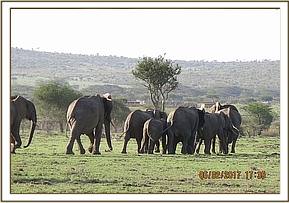
Immobilization, examination and treatment
Restraint was achieved chemically by use of 8mgs Etorphine hydrochloride remotely delivered through a 1.5mls Dan-Inject dart from a vehicle.It took ten minutes for this young bull to be fully immobilized with examination and treatment being carried out immediately. This revealed a deep penetrating wound that appeared to have resulted from spearing. The wound was a couple of days old and already septic.
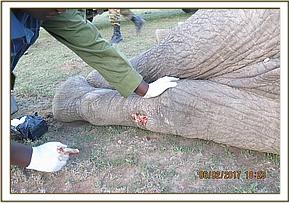
The purulent liquid and necrotic tissues were cleaned out with the help of Hydrogen peroxide and swabs. The wound was then rinsed with copious amount of water and disinfected with tincture of iodine. Green clay was then packed toabsorb toxins and hasten the healing.
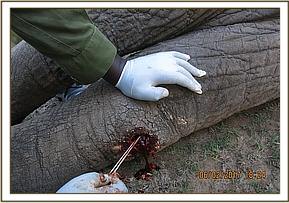
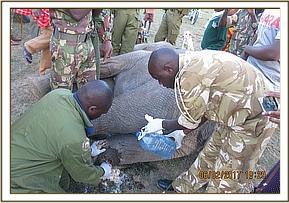

Additional treatments included administration of 7500mgs Amoxicillin anti-biotic and 2500mgs Flunixinmeglumine anti-inflammatory all given intramuscularly.
Reversal and Prognosis
Reversal of the anaesthetic was achieved by use of 18mgs Diprenorphine hydrochloride given through a prominent ear vein. He woke up in three minutes to join the herd. Prognosis is good.
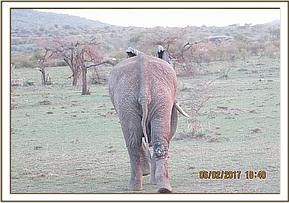
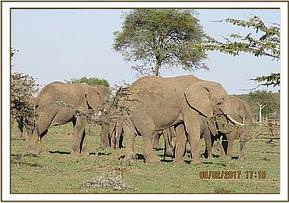
CASE#2 RESCUE OF A BABY ELEPHANT
Date:11th Feb 2017
Species: African elephant
Sex: Female
Age: Approximately 1 year old.
Location: Ngirare in Mara Triangle Conservancy
GPS: 36M0706262 UTM 9845783
History
This baby elephant was spotted in the evening of the day preceding her rescue by Mara Triangle Rangers on patrol. She was in a big herd with a tight snare round her trunk. Mara Triangle management asked their rangers to keep vigil and called on the Mobile Veterinary Unit to come first thing the next morning as it was already late when they spotted her.The next day the herd was found in a forested area. It was obviously difficult to capture her without pushing the herd out of this bush so the services of the Mara Elephant Project helicopter were sought to push the herd out of the thicket.

The herd came out with the baby elephant who appeared to be in great pain.
Immobilization, examination and treatment
The baby elephant was capturedby use of 1mg Etorphine hydrochloride delivered in a 1.5ml Dan- Inject dart from a vehicle. It took ten minutes for the drugs to take full effect. The mother was pushed aside to allow for her examination whichrevealed a tight snare round her trunk that had cut deep and partially exposed the nares. The snare was more proximal on the trunk, a point at which if amputated would leave a small stump about a third of its total length. The elephant was breathing through the damaged part but the distal part of the trunk was still viable.
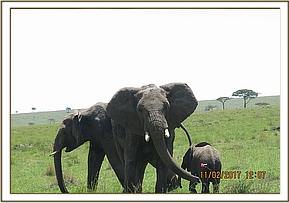
The team arrived at three options, to amputate the trunk, try to reconstruct it or conservative management. However none of the options could be undertaken in the field as this required constant medication and monitoring. Feeding and drinking water would really be difficult without assistance as she recuperates. Her survival in the wild was considered at stake hence after considerations and consultations, the team decided to refer her to DSWT elephant orphanage in Nairobi for possible surgical reconstruction.
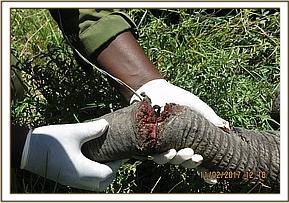
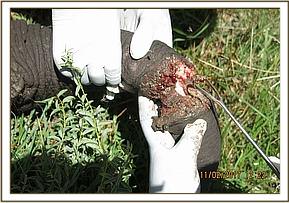
The wound was thoroughly cleaned and temporarily reconstructed before the baby elephant was airlifted to DSWT orphanage for further management. She was given 20mgs Dexamethasone sodium anti-inflammatory intravenously and another 20mgs intramuscularly to ease pain and avoid shock. By the time she was on the plane this baby elephant had metabolised the anaesthetic and was fully conscious on transit.
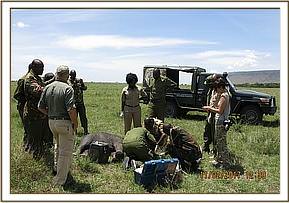
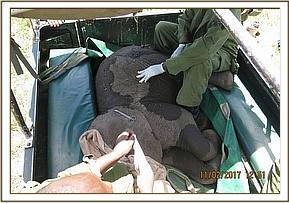
Prognosis
The elephant is currently doing well at the Nairobi Nursery and her wound is being managed. So far amputation has been ruled out though healing is ongoing and it is likely she will only have partial use of her trunk.
CASE#3 RESCUE OF A BUFFALO
Date:11th Feb 2017
Species: Cape buffalo
Sex: Male
Age: Adult
Location: Masai Mara National Reserve (Border with Sentrim lodge)
GPS: 36M 0761823 UTM 9830368
History
This adult male was seen stuck in a swampy area bordering the Sentrim lodge in Masai Mara National Reserve (MMNR) and community area by the Sentrim lodge management. They brought this to the attention of MMNR management who sought our services to rescue him.
Rescue
This buffalo was trying to reach better forage in a swampy area because of the current dry spell. However, he got stuck and could not pull himself out.After several attempts, hewasfatiguedand by the time the team arrived he showed signs of severe exhaustion.
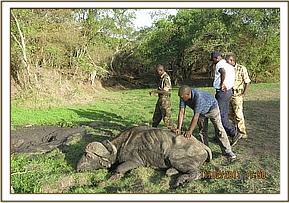
He was pulled out of the swamp with ropes and with no anaesthesia made to lie comfortably. He could not stand up immediately due to excessive fatigue and the rangers were advised to keep watch over him before he gained energy to stand and move.

Prognosis
Poor.His body condition had deteriorated due to the prevailing drought making him an easy target for predators.
CASE#4 TREATMENT OF A GIRAFFE
Date: 12th Feb 2017
Species: Masai giraffe
Sex: Female
Age: Adult
Location: Olarro Conservancy
GPS: 36M0782872 UTM 9838716
History
This female was seen by the rangers of Olarro conservancy with an arrow stuck in her right perinealarea. This occasioned her limping gait with the arrow head visibly seen protruding. The Vet Unit found her isolated from the rest of the herd, moving with difficulty.
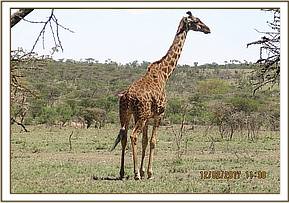
Immobilization, examination and treatment
Restraint was achieved by use of a combination of 12mgs Etorphine hydrochloride and 50mgs Azaperone delivered in a 3mls Dan-Inject dart from a vehicle. When signs of narcotization became evident, she was roped down for effective restraint. She was heavily gravid and treatment was quick so as not to compromise her and the calf’s health.
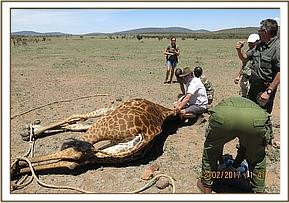
The barbed arrow head was worked out gently and the wound debrided with help of Hydrogen peroxide and gauze swabs. The wound was disinfected with tincture of iodine and packed with green clay to absorb toxins. Additional treatments involved intramuscular administration of 7500mgs Amoxicillin antibiotic and 2500mgs Flunixinmeglumine anti-inflammatory.
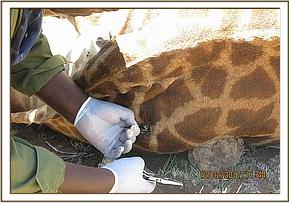
Reversal and Prognosis
Reversal of the anaesthetic was achieved by administration of 24mgs Diprenorphine hydrochloride intravenously through the jugular vein. She woke up with little assistance in three minutes and dashed to join the rest of the herd. Prognosis is good.
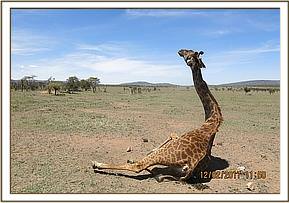
CASE#5 TREATMENT OF A SPEARED ELEPHANT
Date: 12th Feb 2017
Species: African elephant
Sex: Male
Age: Young (10 – 15 years)
Location: Olarro conservancy
GPS: 0782860 UTM 9838700
History
This young bull was spotted close to where the giraffe was being treated as the team was winding up with the giraffe treatment. He was alone in a small bush with a wound to his left flank and seemed to be in a lot of pain.
Immobilization, examination and treatment
Restraint was achieved by use of 11mgs Etorphine hydrochloride delivered through a 1.5ml Dan-Inject dart from a vehicle.It took ten minutes for the drugs to take full effect with the elephant assuming left lateral recumbency. He had to be flipped over for proper examination and treatment to be achieved.
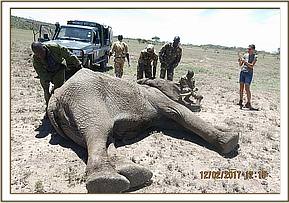
Examination revealed a spear inflicted wound which was approximately one week old and had become septic. No foreign body was detected.
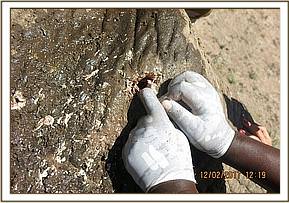
The purulent liquid was effectively drained out and necrotic tissues debrided. Copious amount of clean water was used to lavage the wound before tincture of iodine disinfectant was applied. Finally green clay was packed to promote healing.
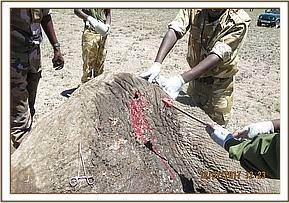
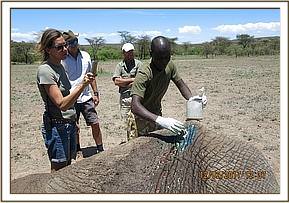
Additional treatments include parenteral administration of 22500mgs Amoxicillin antibiotic and 5000mgs Flunixinmeglumine anti-inflammatory.
Reversal and Prognosis
Reversal of the anaesthetic was achieved by administration of 30mgs Diprenorphine hydrochloride through a prominent ear vein. He woke up in three minutes and walked to a nearby thicket. Prognosis is good.
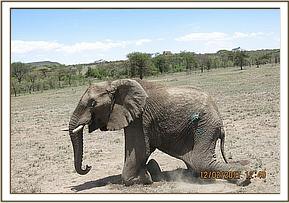
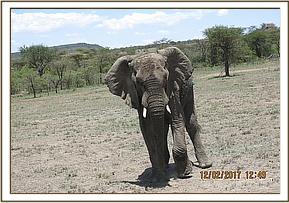
CASE#6 COLLARING OF AN ELEPHANT
Date:17th Feb 2017
Specie: African elephant
Sex:Female
Age: Adult
Location: Shompole
History
With the recent discovery of elephant carcases at Loita forest near Kenya /Tanzania border, stakeholders in wildlife conservation thought there was need to keep track of this group of elephants who are known to stay in Loita forest and sometimes move up to Nguruman in Kajiado.
Given that these areas are poorly accessible due to vegetation and terrain, KWS, Save the Elephants (STE) and Mara Elephant Project (MEP) teams jointly decided to deploy a collar on one of the elephants so that the herds can easily be monitored.
Immobilization and collar deployment
A herd of about 30 elephants was identified having moved up from Loita to Shompole and the second in command female in one of the families was identified as a good candidate.
She was chemically restrained by use of 17mgs Etorphine hydrochloride delivered through a3ml Dan-Inject dart from a helicopter given the status of the terrain. She was guided to a relatively open ground before being darted and restricted from moving back to the forest by helicopter. It took ten minutes for her to be fully narcotized.
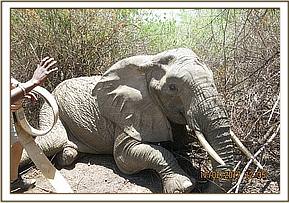
A collar was quickly fitted by the team after ascertaining her soundness. This was a SAT/GSM collar for maximum access and recovery of data. She was given 20000mgs Oxytetracycline hydrochloride intramuscularly for prophylaxis before being reversed.
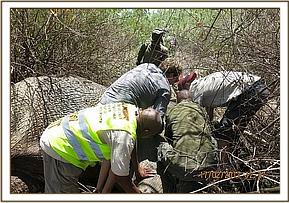
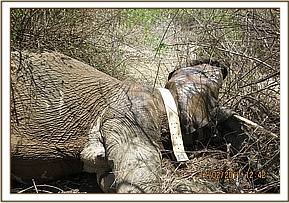
Reversal
The anaesthetic was reversed by administration of a combination of 30mgs Diprenorphine hydrochloride and150mgs Naltrexone intravenously through a prominent ear vein. She woke up in three minutes to join the rest of the herd.
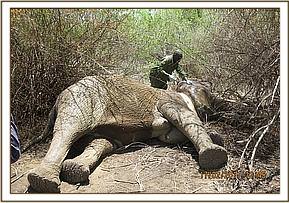
CASE#7 SICK VULTURE
Date: 21st Feb 2017
Species: White backed vulture
Sex: Female
Age: Adult
Location: Base Camp (Talek)
GPS: 36M 0746526 UTM 9839137
This vulture was found partly submerged at Talek River by an employee of Base camp. She showed servere incoordination and flapping of the wings. After picking her from the river he called the mobile veterinary unit for assistance. No other vulture or any other species was seen affected near the area at that time.
General examination
This vulture appeared dehydrated, wasted and fatigued after a lot of struggle. She had a tendency of tucking her head below her left wing and her left eye was partially damaged.
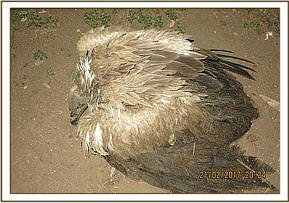
As a precautionary measure she received a dose of Atropine sulphate being antidote of the most commonly used poison in the area, given that they are mostly affected by this. Poisoning was also considered as a differential diagnosis. She also received 0.5mgs Dexamethasone sodium anti-inflammatory all given through breast muscles. She was then put in a relatively warm area and closely monitored. However, she did not survive and succumbed during the night.
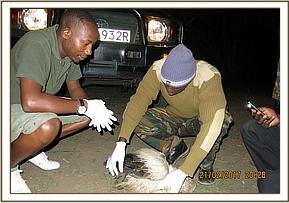
Post mortem was then conducted which revealed, severe dehydration, debility and an entirely empty gastrointestinal tract. No solid food was found in the digestive system, with greenish biliary regurgitates on the upper gastrointestinal tract.
This vulture died of malnutrition and dehydration occasioned by her inability to feed and drink. She could also have been exposed to chronic poisoning. Liver samples were collected for further analysis
Conclusion
Mara Mobile Veterinary Unit would like to thank every stakeholder who helped in one way or the other towards rescue and treatment of animals during the period. We appreciate support given to the unit by Minara Foundation through DSWT whose facilitation has kept services running smoothly and to KWS management for their immense technical support.


































